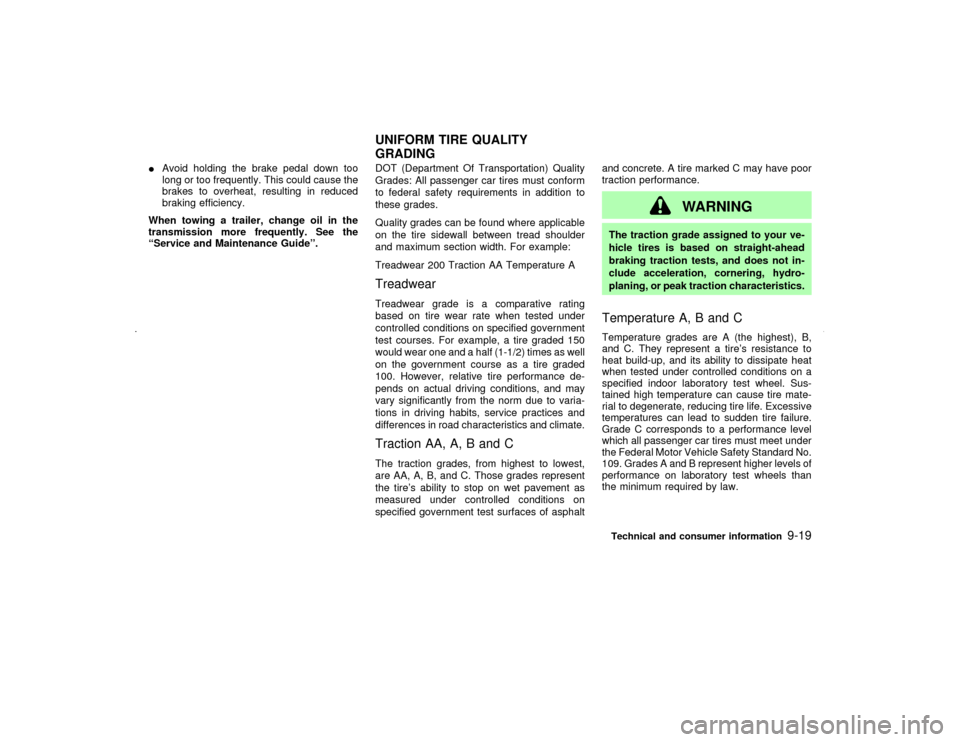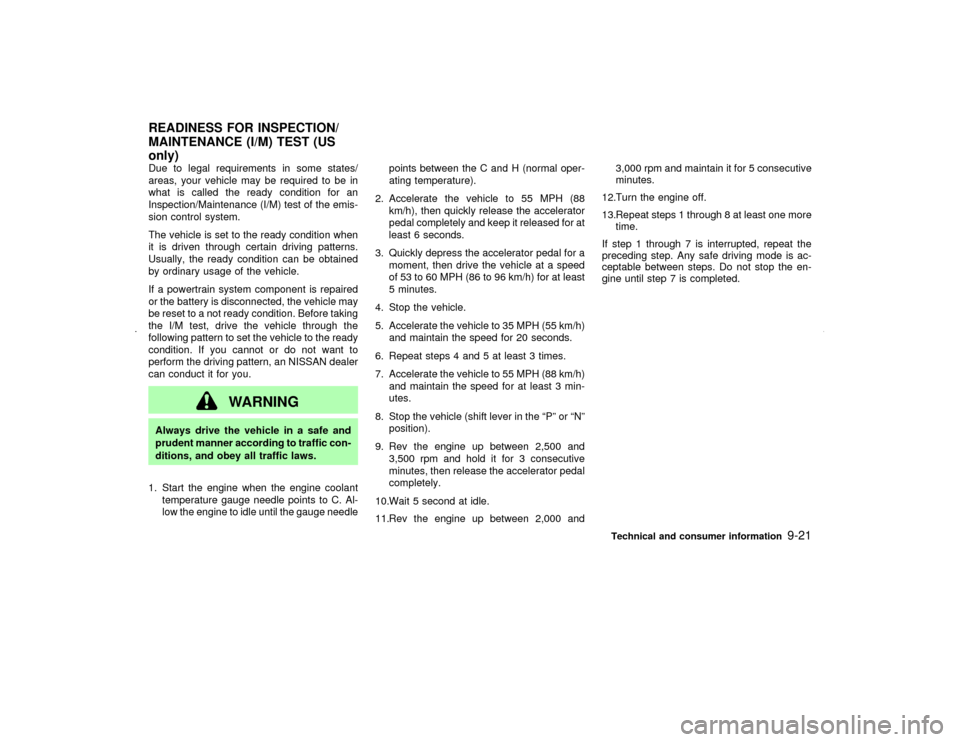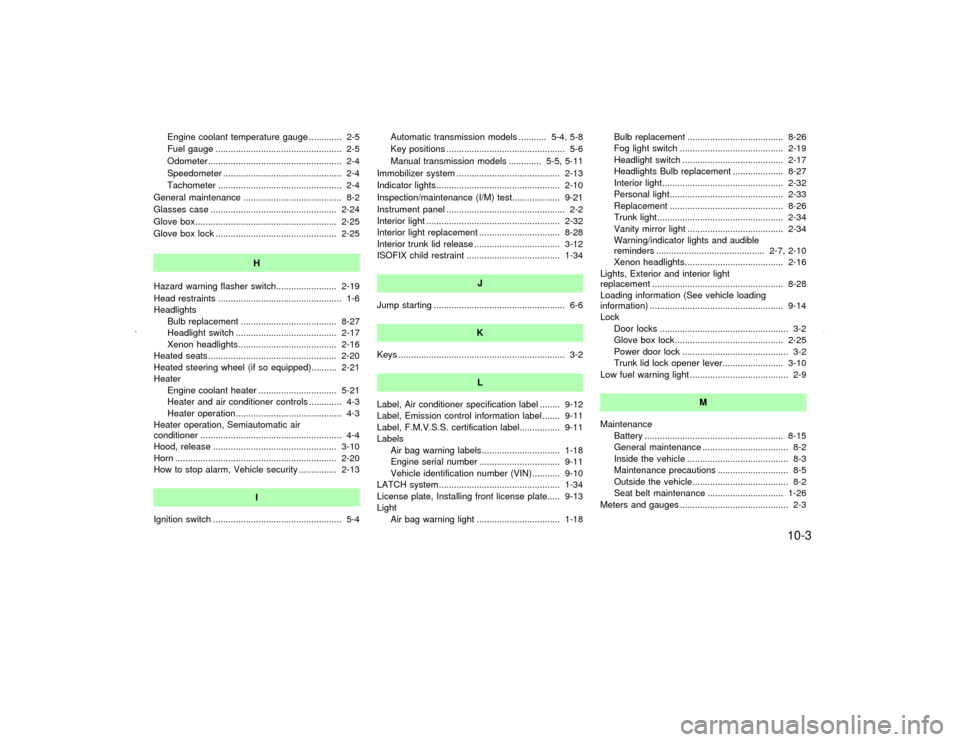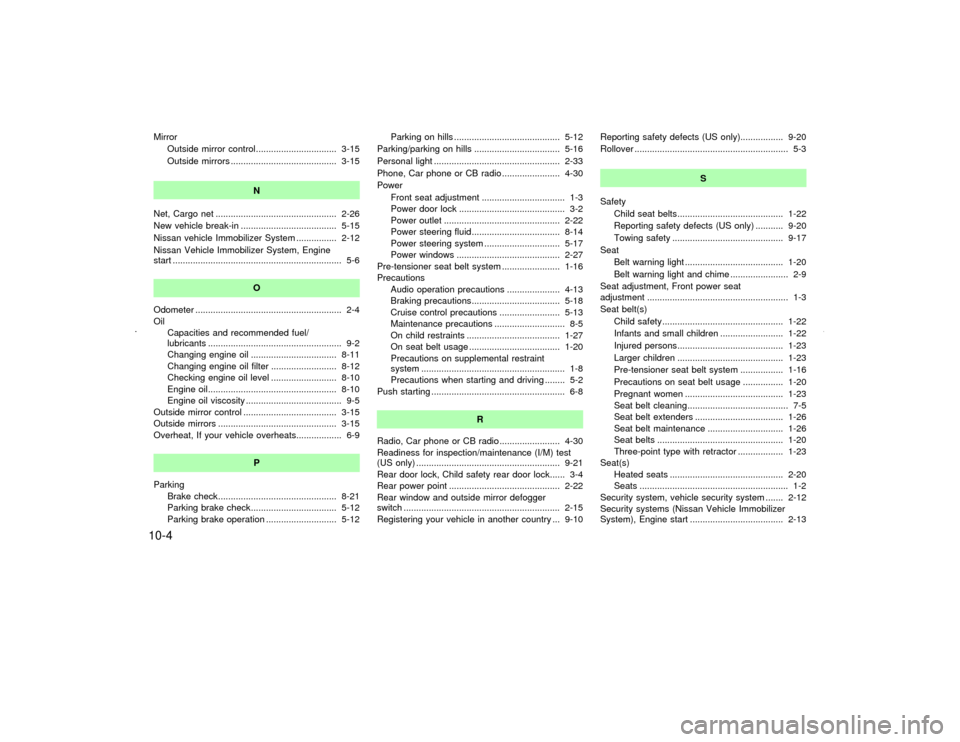2002 NISSAN MAXIMA Maintenance
[x] Cancel search: MaintenancePage 233 of 247

trailer is hitched. Do not drive the vehicle if
it has an abnormal nose-up or nose-down
condition; check for improper tongue load,
overload, worn suspension or other pos-
sible causes of either condition.
IAlways secure items in the trailer to prevent
load shifts while driving.
IBe certain your rear view mirrors conform to
all federal, state or local regulations. If not,
install any mirrors required for towing be-
fore driving the vehicle.
Trailer towing tipsIn order to gain skill and an understanding of
the vehicle's behavior, you should practice
turning, stopping and backing up in an area
which is free from traffic. Steering stability, and
braking performance will be somewhat differ-
ent than under normal driving conditions.
IAlways secure items in the trailer to prevent
load shift while driving.
IAvoid abrupt starts, acceleration or stops.
IAvoid sharp turns or lane changes.
IAlways drive your vehicle at a moderate
speed.
IAlways block the wheels on both vehicle
and trailer when parking. Parking on aslope is not recommended; however, if you
must do so, and if your vehicle is equipped
with automatic transmission, first block the
wheels and apply the parking brake, and
then move the transmission selector lever
into the P (Park) position. If you move the
selector lever to the P (Park) position be-
fore blocking the wheels and applying the
parking brake, transmission damage could
occur.
IWhen going down a hill, shift into a lower
gear and use the engine braking effect.
When ascending a long grade, downshift
the transmission to a lower gear and reduce
speed to reduce chances of engine over-
loading and/or overheating.
IIf the engine coolant rises to an extremely
high temperature when the air conditioning
system is on, turn off the air conditioner.
Coolant heat can be additionally vented by
opening the windows, switching the fan
control to high and setting the temperature
control to the HOT position.
ITrailer towing requires more fuel than nor-
mal circumstances.
IAvoid towing a trailer for the first 500 miles
(800 km).
IHave your vehicle serviced more often thanat intervals specified in the recommended
maintenance schedule.
IWhen making a turn, your trailer wheels will
be closer to the inside of the turn than your
vehicle wheels. To compensate for this,
make a larger than normal turning radius
during the turn.
ICrosswinds and rough roads will adversely
affect vehicle/trailer handling, possibly
causing vehicle sway. When being passed
by larger vehicles, be prepared for possible
changes in crosswinds that could affect
vehicle handling. If swaying does occur,
firmly grip the steering wheel, steer straight
ahead, and immediately (but gradually) re-
duce vehicle speed. This combination will
help stabilize the vehicle. Never increase
speed.
IBe careful when passing other vehicles.
Passing while towing a trailer requires con-
siderably more distance than normal pass-
ing. Remember the length of the trailer
must also pass the other vehicle before you
can safely change lanes.
ITo maintain engine braking efficiency and
electrical charging performance, do not use
fifth gear (manual transmission) or over-
drive (automatic transmission).9-18
Technical and consumer information
Z
01.9.21/A33-D/V5.0
X
Page 234 of 247

IAvoid holding the brake pedal down too
long or too frequently. This could cause the
brakes to overheat, resulting in reduced
braking efficiency.
When towing a trailer, change oil in the
transmission more frequently. See the
ªService and Maintenance Guideº.DOT (Department Of Transportation) Quality
Grades: All passenger car tires must conform
to federal safety requirements in addition to
these grades.
Quality grades can be found where applicable
on the tire sidewall between tread shoulder
and maximum section width. For example:
Treadwear 200 Traction AA Temperature A
TreadwearTreadwear grade is a comparative rating
based on tire wear rate when tested under
controlled conditions on specified government
test courses. For example, a tire graded 150
would wear one and a half (1-1/2) times as well
on the government course as a tire graded
100. However, relative tire performance de-
pends on actual driving conditions, and may
vary significantly from the norm due to varia-
tions in driving habits, service practices and
differences in road characteristics and climate.Traction AA, A, B and CThe traction grades, from highest to lowest,
are AA, A, B, and C. Those grades represent
the tire's ability to stop on wet pavement as
measured under controlled conditions on
specified government test surfaces of asphaltand concrete. A tire marked C may have poor
traction performance.
WARNING
The traction grade assigned to your ve-
hicle tires is based on straight-ahead
braking traction tests, and does not in-
clude acceleration, cornering, hydro-
planing, or peak traction characteristics.Temperature A, B and CTemperature grades are A (the highest), B,
and C. They represent a tire's resistance to
heat build-up, and its ability to dissipate heat
when tested under controlled conditions on a
specified indoor laboratory test wheel. Sus-
tained high temperature can cause tire mate-
rial to degenerate, reducing tire life. Excessive
temperatures can lead to sudden tire failure.
Grade C corresponds to a performance level
which all passenger car tires must meet under
the Federal Motor Vehicle Safety Standard No.
109. Grades A and B represent higher levels of
performance on laboratory test wheels than
the minimum required by law.
UNIFORM TIRE QUALITY
GRADING
Technical and consumer information
9-19
Z
01.9.21/A33-D/V5.0
X
Page 236 of 247

Due to legal requirements in some states/
areas, your vehicle may be required to be in
what is called the ready condition for an
Inspection/Maintenance (I/M) test of the emis-
sion control system.
The vehicle is set to the ready condition when
it is driven through certain driving patterns.
Usually, the ready condition can be obtained
by ordinary usage of the vehicle.
If a powertrain system component is repaired
or the battery is disconnected, the vehicle may
be reset to a not ready condition. Before taking
the I/M test, drive the vehicle through the
following pattern to set the vehicle to the ready
condition. If you cannot or do not want to
perform the driving pattern, an NISSAN dealer
can conduct it for you.
WARNING
Always drive the vehicle in a safe and
prudent manner according to traffic con-
ditions, and obey all traffic laws.
1. Start the engine when the engine coolant
temperature gauge needle points to C. Al-
low the engine to idle until the gauge needlepoints between the C and H (normal oper-
ating temperature).
2. Accelerate the vehicle to 55 MPH (88
km/h), then quickly release the accelerator
pedal completely and keep it released for at
least 6 seconds.
3. Quickly depress the accelerator pedal for a
moment, then drive the vehicle at a speed
of 53 to 60 MPH (86 to 96 km/h) for at least
5 minutes.
4. Stop the vehicle.
5. Accelerate the vehicle to 35 MPH (55 km/h)
and maintain the speed for 20 seconds.
6. Repeat steps 4 and 5 at least 3 times.
7. Accelerate the vehicle to 55 MPH (88 km/h)
and maintain the speed for at least 3 min-
utes.
8. Stop the vehicle (shift lever in the ªPº or ªNº
position).
9. Rev the engine up between 2,500 and
3,500 rpm and hold it for 3 consecutive
minutes, then release the accelerator pedal
completely.
10.Wait 5 second at idle.
11.Rev the engine up between 2,000 and3,000 rpm and maintain it for 5 consecutive
minutes.
12.Turn the engine off.
13.Repeat steps 1 through 8 at least one more
time.
If step 1 through 7 is interrupted, repeat the
preceding step. Any safe driving mode is ac-
ceptable between steps. Do not stop the en-
gine until step 7 is completed.READINESS FOR INSPECTION/
MAINTENANCE (I/M) TEST (US
only)
Technical and consumer information
9-21
Z
01.9.21/A33-D/V5.0
X
Page 242 of 247

Engine coolant temperature gauge ............. 2-5
Fuel gauge .................................................. 2-5
Odometer..................................................... 2-4
Speedometer ............................................... 2-4
Tachometer ................................................. 2-4
General maintenance ....................................... 8-2
Glasses case .................................................. 2-24
Glove box........................................................ 2-25
Glove box lock ................................................ 2-25
H
Hazard warning flasher switch........................ 2-19
Head restraints ................................................. 1-6
Headlights
Bulb replacement ...................................... 8-27
Headlight switch ........................................ 2-17
Xenon headlights....................................... 2-16
Heated seats................................................... 2-20
Heated steering wheel (if so equipped).......... 2-21
Heater
Engine coolant heater ............................... 5-21
Heater and air conditioner controls ............. 4-3
Heater operation.......................................... 4-3
Heater operation, Semiautomatic air
conditioner ........................................................ 4-4
Hood, release ................................................. 3-10
Horn ................................................................ 2-20
How to stop alarm, Vehicle security ............... 2-13
I
Ignition switch ................................................... 5-4Automatic transmission models ........... 5-4, 5-8
Key positions ............................................... 5-6
Manual transmission models ............. 5-5, 5-11
Immobilizer system ......................................... 2-13
Indicator lights................................................. 2-10
Inspection/maintenance (I/M) test................... 9-21
Instrument panel ............................................... 2-2
Interior light ..................................................... 2-32
Interior light replacement ................................ 8-28
Interior trunk lid release .................................. 3-12
ISOFIX child restraint ..................................... 1-34
J
Jump starting .................................................... 6-6
K
Keys .................................................................. 3-2
L
Label, Air conditioner specification label ........ 9-12
Label, Emission control information label ....... 9-11
Label, F.M.V.S.S. certification label................ 9-11
Labels
Air bag warning labels............................... 1-18
Engine serial number ................................ 9-11
Vehicle identification number (VIN)........... 9-10
LATCH system................................................ 1-34
License plate, Installing front license plate..... 9-13
Light
Air bag warning light ................................. 1-18Bulb replacement ...................................... 8-26
Fog light switch ......................................... 2-19
Headlight switch ........................................ 2-17
Headlights Bulb replacement .................... 8-27
Interior light................................................ 2-32
Personal light............................................. 2-33
Replacement ............................................. 8-26
Trunk light.................................................. 2-34
Vanity mirror light ...................................... 2-34
Warning/indicator lights and audible
reminders ........................................... 2-7, 2-10
Xenon headlights....................................... 2-16
Lights, Exterior and interior light
replacement .................................................... 8-28
Loading information (See vehicle loading
information) ..................................................... 9-14
Lock
Door locks ................................................... 3-2
Glove box lock........................................... 2-25
Power door lock .......................................... 3-2
Trunk lid lock opener lever........................ 3-10
Low fuel warning light ....................................... 2-9
M
Maintenance
Battery ....................................................... 8-15
General maintenance .................................. 8-2
Inside the vehicle ........................................ 8-3
Maintenance precautions ............................ 8-5
Outside the vehicle...................................... 8-2
Seat belt maintenance .............................. 1-26
Meters and gauges ........................................... 2-3
Z
01.9.21/A33-D/V5.0
X
10-3
Page 243 of 247

Mirror
Outside mirror control................................ 3-15
Outside mirrors .......................................... 3-15
N
Net, Cargo net ................................................ 2-26
New vehicle break-in ...................................... 5-15
Nissan vehicle Immobilizer System ................ 2-12
Nissan Vehicle Immobilizer System, Engine
start ................................................................... 5-6
O
Odometer .......................................................... 2-4
Oil
Capacities and recommended fuel/
lubricants ..................................................... 9-2
Changing engine oil .................................. 8-11
Changing engine oil filter .......................... 8-12
Checking engine oil level .......................... 8-10
Engine oil................................................... 8-10
Engine oil viscosity ...................................... 9-5
Outside mirror control ..................................... 3-15
Outside mirrors ............................................... 3-15
Overheat, If your vehicle overheats.................. 6-9
P
Parking
Brake check............................................... 8-21
Parking brake check.................................. 5-12
Parking brake operation ............................ 5-12Parking on hills .......................................... 5-12
Parking/parking on hills .................................. 5-16
Personal light .................................................. 2-33
Phone, Car phone or CB radio ....................... 4-30
Power
Front seat adjustment ................................. 1-3
Power door lock .......................................... 3-2
Power outlet .............................................. 2-22
Power steering fluid................................... 8-14
Power steering system .............................. 5-17
Power windows ......................................... 2-27
Pre-tensioner seat belt system ....................... 1-16
Precautions
Audio operation precautions ..................... 4-13
Braking precautions................................... 5-18
Cruise control precautions ........................ 5-13
Maintenance precautions ............................ 8-5
On child restraints ..................................... 1-27
On seat belt usage .................................... 1-20
Precautions on supplemental restraint
system ......................................................... 1-8
Precautions when starting and driving ........ 5-2
Push starting ..................................................... 6-8
R
Radio, Car phone or CB radio ........................ 4-30
Readiness for inspection/maintenance (I/M) test
(US only) ......................................................... 9-21
Rear door lock, Child safety rear door lock...... 3-4
Rear power point ............................................ 2-22
Rear window and outside mirror defogger
switch .............................................................. 2-15
Registering your vehicle in another country ... 9-10Reporting safety defects (US only)................. 9-20
Rollover ............................................................. 5-3
S
Safety
Child seat belts.......................................... 1-22
Reporting safety defects (US only) ........... 9-20
Towing safety ............................................ 9-17
Seat
Belt warning light ....................................... 1-20
Belt warning light and chime ....................... 2-9
Seat adjustment, Front power seat
adjustment ........................................................ 1-3
Seat belt(s)
Child safety................................................ 1-22
Infants and small children ......................... 1-22
Injured persons.......................................... 1-23
Larger children .......................................... 1-23
Pre-tensioner seat belt system ................. 1-16
Precautions on seat belt usage ................ 1-20
Pregnant women ....................................... 1-23
Seat belt cleaning........................................ 7-5
Seat belt extenders ................................... 1-26
Seat belt maintenance .............................. 1-26
Seat belts .................................................. 1-20
Three-point type with retractor .................. 1-23
Seat(s)
Heated seats ............................................. 2-20
Seats ........................................................... 1-2
Security system, vehicle security system ....... 2-12
Security systems (Nissan Vehicle Immobilizer
System), Engine start ..................................... 2-13
Z
01.9.21/A33-D/V5.0
X
10-4